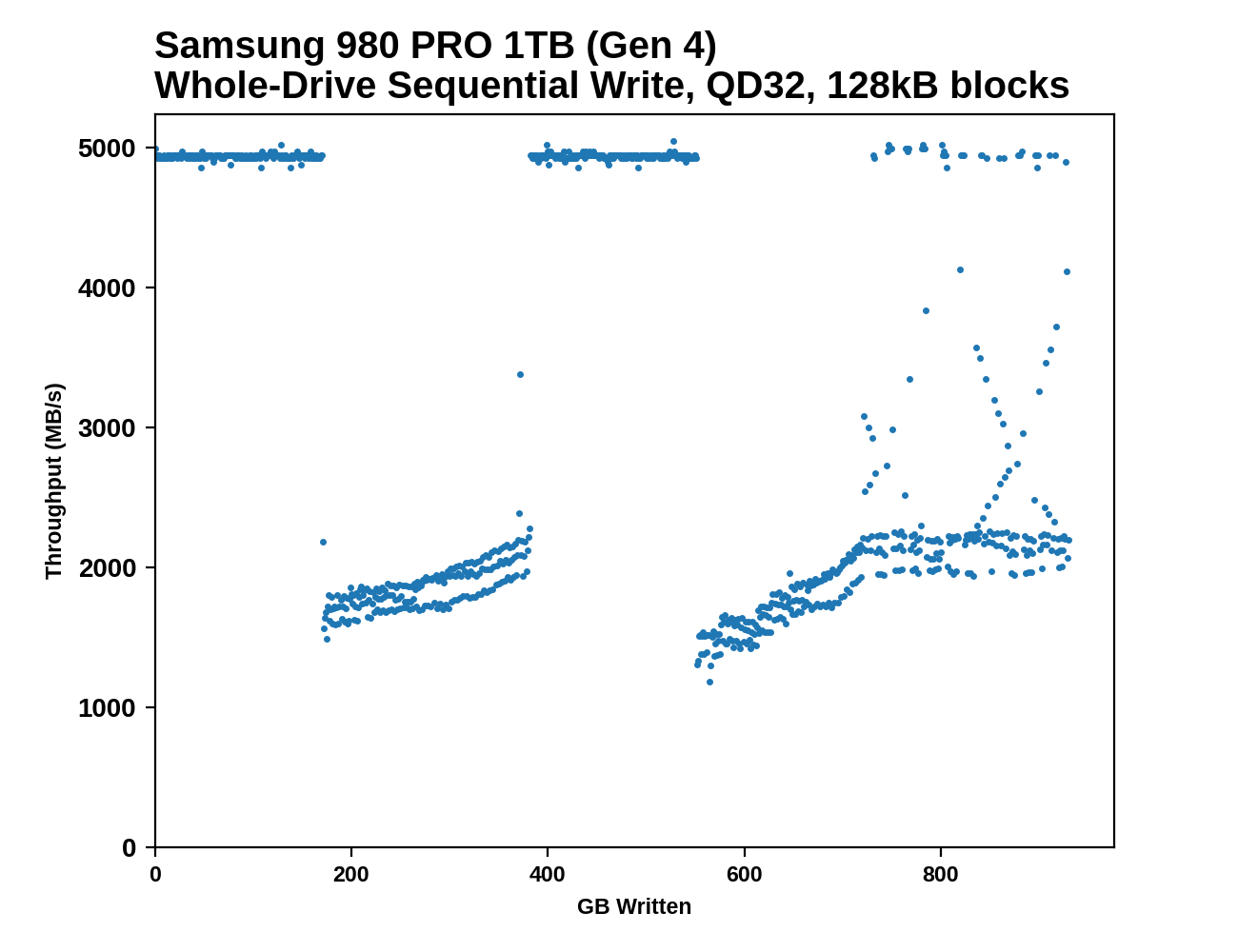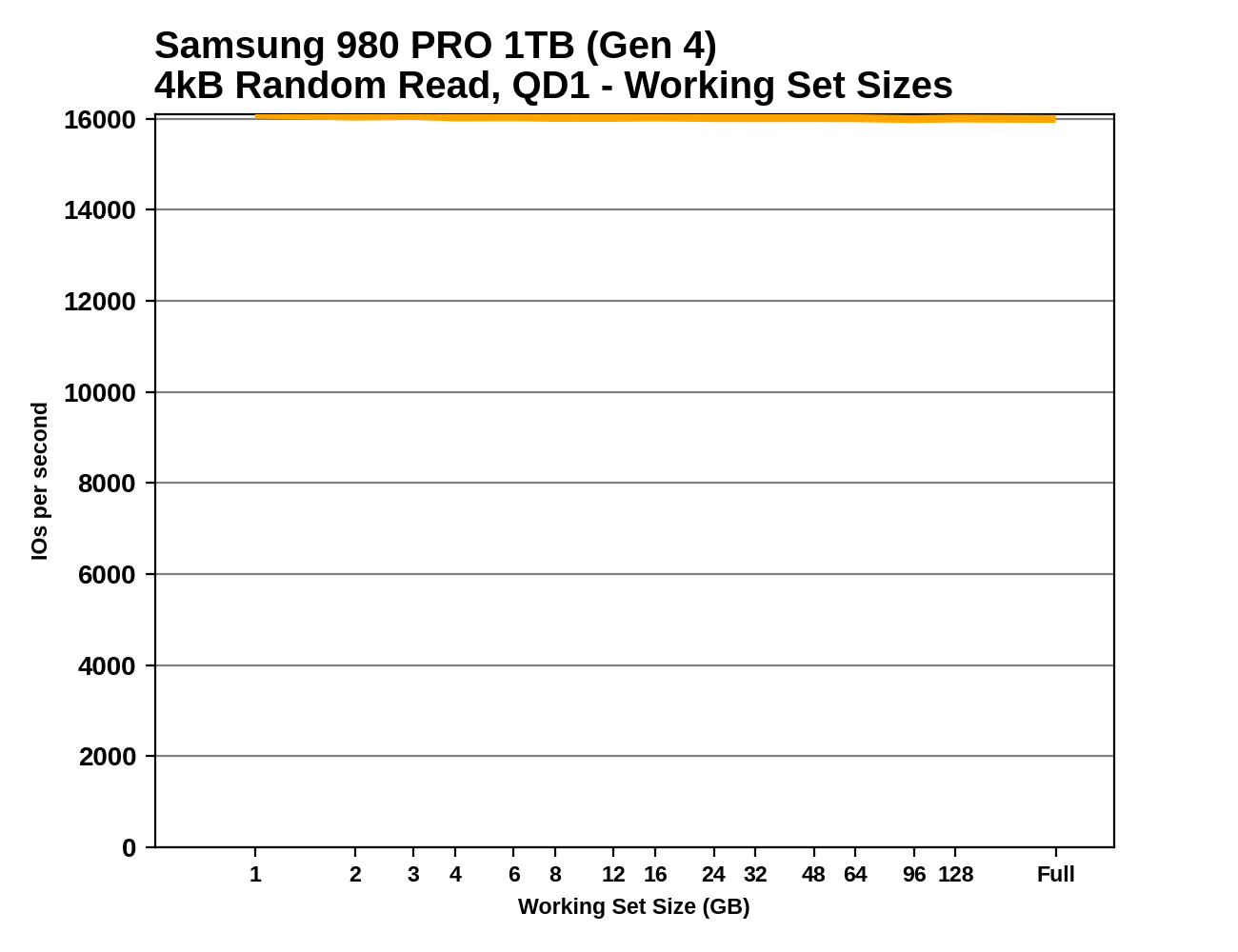The Samsung 980 PRO PCIe 4.0 SSD Review: A Spirit of Hope
by Billy Tallis on September 22, 2020 11:20 AM ESTWhole-Drive Fill
This test starts with a freshly-erased drive and fills it with 128kB sequential writes at queue depth 32, recording the write speed for each 1GB segment. This test is not representative of any ordinary client/consumer usage pattern, but it does allow us to observe transitions in the drive's behavior as it fills up. This can allow us to estimate the size of any SLC write cache, and get a sense for how much performance remains on the rare occasions where real-world usage keeps writing data after filling the cache.
 |
|||||||||
Both tested capacities of the 980 PRO perform more or less as advertised at the start of the test: 5GB/s writing to the SLC cache on the 1TB model and 2.6GB/s writing to the cache on the 250GB model - the 1 TB model only hits 3.3 GB/s when in PCIe 3.0 mode. Surprisingly, the apparent size of the SLC caches is larger than advertised, and larger when testing on PCIe 4 than on PCIe 3: the 1TB model's cache (rated for 114GB) lasts about 170GB @ Gen4 speeeds and about 128GB @ Gen3 speeds, and the 250GB model's cache (rated for 49GB) lasts for about 60GB on Gen4 and about 49GB on Gen3. If anything it seems that these SLC cache areas are quoted more for PCIe 3.0 than PCIe 4.0 - under PCIe 4.0 however, there might be a chance to free up some of the SLC as the drive writes to other SLC, hence the increase.
An extra twist for the 1TB model is that partway through the drive fill process, performance returns to SLC speeds and stays there just as long as it did initially: another 170GB written at 5GB/s (124GB written at 3.3GB/s on Gen3). Looking back at the 970 EVO Plus and 970 EVO we can see similar behavior, but it's impressive Samsung was able to continue this with the 980 PRO while providing much larger SLC caches—in total, over a third of the drive fill process ran at the 5GB/s SLC speed, and performance in the TLC writing phases was still good in spite of the background work to flush the SLC cache.
 |
|||||||||
| Average Throughput for last 16 GB | Overall Average Throughput | ||||||||
On the Gen4 testbed, the overall average throughput of filling the 1TB 980 PRO is only slightly slower than filling the MLC-based 970 PRO, and far faster than the other 1TB TLC drives. Even when limited by PCIe Gen3, the 980 Pro's throughput remains in the lead. The smaller 250GB model doesn't make good use of PCIe Gen4 bandwidth during this sequential write test, but it is a clear improvement over the same capacity of the 970 EVO Plus.
Working Set Size
Most mainstream SSDs have enough DRAM to store the entire mapping table that translates logical block addresses into physical flash memory addresses. DRAMless drives only have small buffers to cache a portion of this mapping information. Some NVMe SSDs support the Host Memory Buffer feature and can borrow a piece of the host system's DRAM for this cache rather needing lots of on-controller memory.
When accessing a logical block whose mapping is not cached, the drive needs to read the mapping from the full table stored on the flash memory before it can read the user data stored at that logical block. This adds extra latency to read operations and in the worst case may double random read latency.
We can see the effects of the size of any mapping buffer by performing random reads from different sized portions of the drive. When performing random reads from a small slice of the drive, we expect the mappings to all fit in the cache, and when performing random reads from the entire drive, we expect mostly cache misses.
When performing this test on mainstream drives with a full-sized DRAM cache, we expect performance to be generally constant regardless of the working set size, or for performance to drop only slightly as the working set size increases.
 |
|||||||||
Since these are all high-end drives, we don't see any of the read performance drop-off we expect from SSDs with limited or no DRAM buffers. The two drives using Silicon Motion controllers show a little bit of variation depending on the working set size, but ultimately are just as fast when performing random reads across the whole drive as they are reading from a narrow range. The read latency measured here for the 980 PRO is an improvement of about 15% over the 970 EVO Plus, but is not as fast as the MLC-based 970 PRO.










137 Comments
View All Comments
msroadkill612 - Tuesday, October 13, 2020 - link
Yep. I find the raw sequential speeds exciting too - its not just about IOPS :)This processor load balancing coincides w/ some very handy advances in mainstream system memory - typically? 64GB (2x 32GB 3200 cl16 ~$220 atm) w/ speeds to ~45-50GB/s on AM4?,
a PCIE 4 GPU w/ a 32GB/s link vs the former 16GB/s. Its little mentioned, but seems an important plateau - ~64GB at 32GB/s seems a pretty usable supplemental tier of cache for the gpu?
quite possibly, nvme ports on the GPU's Infinity Fabric bus on ~BigNavi to bypass a potentially bottlenecked pcie bus - AMD did it before with a pro Vega card - an nvme raid array on the gpu.
individually they are increments in currently usable gaming memory & bandwidth (if not IOPS), but collectively they could be a force which affects gaming?
Games are what they are due to the restrictions of yore. Of course they are coded to isolate within gpu resources.. it was the only way to run fast enough. Reduce the restrictions tho, & add new usable resources, & games change to provide new & richer experiences.
MS FS is perhaps a forerunner of this new mindset - it likes massive memory, but is fun at 30FPS.
crabperson - Tuesday, September 22, 2020 - link
Thanks for the comparison to the PM1725a, I didn't realize how the lack of an SLC cache hurt it so much! I got a used 3.2 TB 'b version for a song, still holding out on Haswell here and probably won't upgrade until next year (Zen 3 may convince me otherwise).Looking forward to Phison's updated controllers and 2TB+ drives next year. Definitely don't need to waste money on the Pro line anymore.
Billy Tallis - Tuesday, September 22, 2020 - link
I was actually surprised how poorly the PM1725a fared on the consumer tests. I knew that the lack of SLC caching would hurt its writes, but it also appears to be heavily optimized for high queue depths at the expense of low queue depth performance.I'm planning to have some overlap between the enterprise and consumer synthetic benchmarks going forward, so there should be more opportunities to notice stuff like this.
ZeDestructor - Tuesday, September 22, 2020 - link
Any particular reson for not running the 3 desktop loads as well? I'm curious how the drives perform in more "real-world" desktop workloads tooBilly Tallis - Tuesday, September 22, 2020 - link
Time constraints, mostly. I grabbed the PM1725a because of its potential to show similar peak throughput, and it takes less than two hours to run the synthetic tests. A full set of ATSB results is a minimum of 12 hours plus however long it takes to fill the drive twice.ZeDestructor - Wednesday, September 23, 2020 - link
Couldn't you do it during downtime and then lump the results directly into bench? I'm not particularly fussed about having the results in this particular review, but they would be very nice to have around eventually™ for weirdos like me who buy used server drives for cheap and stick em into the desktop.PopinFRESH007 - Tuesday, September 22, 2020 - link
The Rocket 4 Plus was already announced and should be shipping this year with what looks to be better performance than this. Will be interesting to see what the price will be. The E18 also supports NVMe 1.4 rather than 1.3c on the 980 Pro.ToTTenTranz - Tuesday, September 22, 2020 - link
So.. is this a SSD that can go into the PS5 as expandable storage?Billy Tallis - Tuesday, September 22, 2020 - link
Probably. Sony hasn't put out their list of officially approved/tested SSDs yet, but this one should qualify and then some.UltraWide - Tuesday, September 22, 2020 - link
The RANDOM R/W scores are average. It looks like the SK Hynix is a better SSD for real world use.